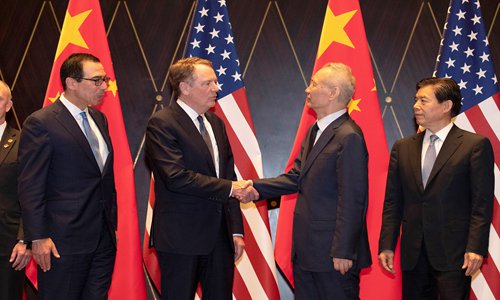Phase one trade deal not a threat, but a life saver for US
Source:Global Times Published: 2020/5/8 14:41:48 Last Updated: 2020/5/8 18:39:09

Chinese Vice Premier Liu He shakes hands with US Trade Representative Robert Lighthizer before a photo session after a round of trade talks in Shanghai on July 31, 2019. Photo: VCG
US chief trade negotiators invited China’s Vice Premier Liu He to speak on Fri, and also vowed to “create conditions” for a trade deal. The US’ sharp shift in attitude toward China indicates some in the US have realized they need China to save their “risky economy,”while also revealing the US’ inability to supply relevant products to China due to failures in COVID-19 management, experts close to the trade talks said.
Liu was invited to talk with US Trade Representative Robert Lighthizer and Treasury Secretary Steven Mnuchin by phone on Friday. The two vowed to create favorable conditions for the implementation of the phase one trade deal, while cooperating on the economy and public health, according to a report from the Xinhua News Agency.
They also agreed to maintain communications during the phone call, Xinhua said.
The planned phone call was the first conversation about the agreement between the two countries’ chief negotiators since it was signed in January. It came after US President Donald Trump threatened to “terminate” the trade deal if China fails in its promise to purchase specific goods and services from the US.
The US has been wracking its brains seeking ways to redirect its own mismanagement of the coronavirus toward China. The contrast in attitude indicates a worse-than-expected domestic economic situation has caused some in the country to realize that only cooperation with China can save the US economy from the brink of disaster, Sang Baichuan, director of the Institute of International Business at the University of International Business and Economics, told the Global Times on Friday.
Nearly 3.2 million US workers have sought unemployment aid, with total layoffs since the virus hit the country rising to 33 million as business shutdowns deepen the worst US economic catastrophe in decades, the Associated Press reported on Thursday.
On the other side, the Chinese economy has been showing a steady recovery over recent months. Thursday's customs data showed China's yuan-denominated exports increased 8.2 percent year-on-year to 1.41 trillion yuan ($200 billion) in April, beating market expectations of double-digit negative growth. Imports were recorded at 1.09 trillion yuan, down 10.2 percent on a yearly basis.
“[The US] now hopes China’s expanding imports can alleviate its domestic situation,” Sang said.
However, Gao Lingyun, an expert at the Chinese Academy of Social Sciences who advises the government on trade issues, said the US may now face another problem: it is unable to provide the quantity of products China now needs as the virus has undercut its production ability.
“So it’s now on the US to determine whether or not the two can smoothly carry out the deal,” Gao said, noting that improving bilateral ties between the world’s two largest economies will be the fastest way to rescue the global economy from the pandemic blow.
“But faced with mounting pressure to handle the COVID-19 pandemic, as well as the upcoming presidential election, the US will not relinquish its China card and will continue in its capricious attitude in the future,” Sang said.
China has shown sincerity and played its part in the phase one trade pact. Its attitude has not been altered by the pandemic, but an agreement can only be implemented through efforts from both sides, experts said.
China’s trade with the US continued to drop from January to April amid the COVID-19 pandemic, with the total value of China-US trade down 12.8 percent to 958.46 billion yuan. China's imports from the US have slid 3 percent, while exports have plunged 15.9 percent, official data showed on Thursday.
Global Times
Posted in: ECONOMY